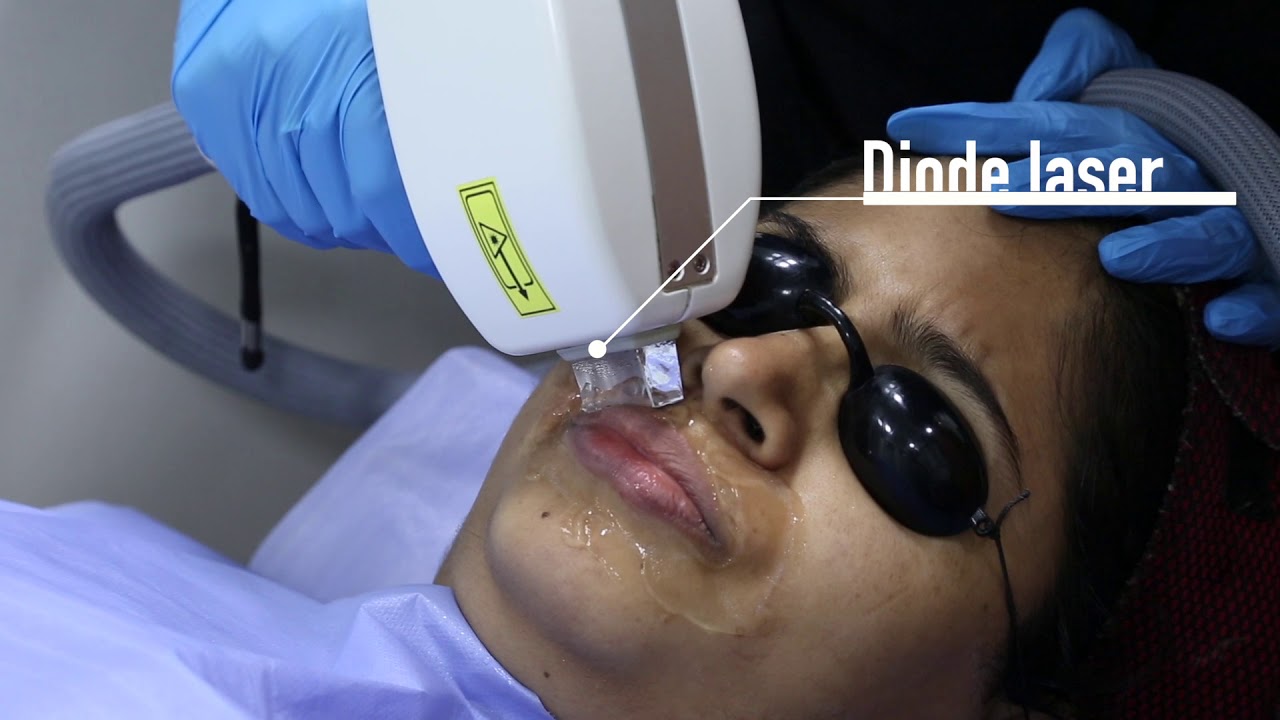Home>FAQs>What Is The Difference Between Laser Hair Removal And Electrolysis


FAQs
What Is The Difference Between Laser Hair Removal And Electrolysis
Modified: September 23, 2023
Discover the key distinctions between laser hair removal and electrolysis. Find answers to your general questions and make an informed decision.
(Many of the links in this article redirect to a specific reviewed product. Your purchase of these products through affiliate links helps to generate commission for Under-tec.com, at no extra cost. Learn more)
Table of Contents
- Introduction
- Brief Overview of Laser Hair Removal
- Brief Overview of Electrolysis
- Comparison of Laser Hair Removal and Electrolysis
- Factors to Consider when Choosing between Laser Hair Removal and Electrolysis
- Effectiveness of Laser Hair Removal and Electrolysis
- Cost Comparison of Laser Hair Removal and Electrolysis
- Pain and Discomfort Comparison of Laser Hair Removal and Electrolysis
- Side Effects and Risks of Laser Hair Removal and Electrolysis
- Suitability for Different Hair and Skin Types
- Conclusion
Introduction
Laser hair removal and electrolysis are both popular methods used to achieve long-lasting hair removal results. Whether you’re tired of constantly shaving, waxing, or using other temporary hair removal methods, these two options offer more permanent solutions. However, it’s important to understand the differences between laser hair removal and electrolysis to determine which method is best for you.
Laser hair removal uses a concentrated beam of light to target the pigment in the hair follicles. This light energy is absorbed by the hair follicles, heating them up and destroying them in the process. On the other hand, electrolysis involves the insertion of a fine needle into each individual hair follicle. A small electrical current is then passed through the needle, destroying the hair follicle and preventing future hair growth.
Both laser hair removal and electrolysis have their own unique benefits and limitations. Understanding these differences is crucial to making an informed decision about which method is most suitable for your needs. In this article, we will delve deeper into the details of laser hair removal and electrolysis, providing you with the necessary information to help you choose the right hair removal technique.
Brief Overview of Laser Hair Removal
Laser hair removal is a popular cosmetic procedure that uses laser technology to remove unwanted hair from various areas of the body. It works by emitting a concentrated beam of light that is absorbed by the pigment in the hair follicle. This light energy is converted into heat, which damages the hair follicle and inhibits future hair growth.
One of the major advantages of laser hair removal is its precision. The laser targets the dark pigment in the hair follicle, leaving the surrounding skin undamaged. This makes it a suitable option for removing unwanted hair from sensitive areas such as the face, bikini line, and underarms.
Another benefit of laser hair removal is its speed. The laser can treat multiple hair follicles at once, making it a time-efficient method. The duration of the treatment session varies depending on the size of the treatment area, with smaller areas such as the upper lip taking a few minutes, while larger areas like the legs can take up to an hour.
It’s important to note that laser hair removal is most effective on dark, coarse hair. The laser targets the melanin in the hair follicle, so individuals with lighter hair may not see the same level of results. However, advancements in laser technology have made it possible to treat a wider range of hair colors and skin types.
While laser hair removal offers long-lasting results, multiple sessions are typically required to achieve optimal outcomes. This is because the hair growth cycle consists of multiple phases, and the laser is most effective during the active growth phase. As a result, a series of treatments spaced several weeks apart is necessary to target all the hair follicles.
Brief Overview of Electrolysis
Electrolysis is a hair removal technique that has been in use for over a century. Unlike laser hair removal, which targets the pigment in the hair follicle, electrolysis works by inserting a fine needle into each individual hair follicle. A small electrical current is then applied to destroy the hair follicle and prevent future hair growth.
One of the advantages of electrolysis is its ability to treat hairs of any color and texture, making it suitable for individuals with light or blonde hair. It is also an effective option for people with darker skin tones, as it does not rely on the contrast between hair color and skin tone like laser hair removal does.
Electrolysis is considered a permanent hair removal method, as it destroys the hair follicle, preventing regrowth. However, achieving permanent results may require multiple sessions. The number of sessions needed depends on various factors, including the density of hair in the treatment area and the individual’s response to the treatment.
It’s important to note that electrolysis is a time-consuming process. Unlike laser hair removal, which can target multiple hair follicles simultaneously, electrolysis treats one hair follicle at a time. Therefore, larger areas may require several sessions to complete the treatment.
While electrolysis is generally safe, it does carry some risks. The most common side effect is temporary skin redness and irritation at the treatment site. In rare cases, scarring or infection may occur. It’s crucial to choose a qualified and experienced electrologist to minimize the risk of complications.
In recent years, advancements in technology have led to the development of different types of electrolysis, including galvanic and thermolysis. Galvanic electrolysis uses a chemical reaction to destroy the hair follicle, while thermolysis uses high-frequency electric currents. Some electrologists combine both methods, using a technique called blend electrolysis, for enhanced results.
Overall, electrolysis is a versatile hair removal method that offers permanent results for individuals with a wide range of hair colors and skin tones. However, it is essential to consult with a qualified electrologist to determine if electrolysis is the right choice for your specific needs.
Comparison of Laser Hair Removal and Electrolysis
When deciding between laser hair removal and electrolysis, it’s important to consider various factors to determine which method is best suited for your needs. Let’s compare these two hair removal techniques based on their effectiveness, costs, pain levels, side effects, and suitability for different hair and skin types.
Effectiveness: Both laser hair removal and electrolysis offer long-term hair reduction, but their effectiveness may vary depending on factors such as hair color, skin tone, and hair density. Laser hair removal is most effective on individuals with dark, coarse hair, while electrolysis is suitable for all hair colors and types.
Cost: In general, laser hair removal tends to be more expensive than electrolysis. The cost of laser treatment is determined by the size of the treatment area and the number of sessions required, while electrolysis is typically priced by the time spent on each session.
Pain and Discomfort: Laser hair removal is often described as feeling like a rubber band snapping against the skin. The sensation can vary depending on the individual’s pain tolerance and the treatment area. On the other hand, electrolysis involves inserting a needle into each hair follicle, which can cause a slight stinging or pricking sensation. The level of discomfort may also vary based on the individual’s pain threshold.
Side Effects and Risks: Laser hair removal may cause temporary side effects such as redness, swelling, and slight skin irritation, which usually subside within a few hours. With electrolysis, the most common side effect is temporary redness at the treatment site. In rare cases, both methods can lead to scarring, pigmentation changes, or infection if not performed correctly. Choosing a qualified professional is crucial to minimize the risk of complications.
Suitability for Different Hair and Skin Types: Laser hair removal works best on individuals with light skin and dark hair due to the contrast between the hair pigment and skin tone. However, advancements in laser technology have made it possible to treat a wider range of hair and skin types. Electrolysis, on the other hand, is suitable for all hair colors and skin tones.
Overall, both laser hair removal and electrolysis are effective methods for long-term hair removal. Laser hair removal is a suitable option for individuals with dark, coarse hair and can cover larger treatment areas quickly. On the other hand, electrolysis offers versatility and can be used on all hair colors and skin types, making it a great choice for individuals with lighter hair or darker skin.
Ultimately, the decision between laser hair removal and electrolysis depends on your specific needs and preferences. It’s recommended to consult with a qualified professional to assess your unique situation and determine which method will provide you with the best results.
Factors to Consider when Choosing between Laser Hair Removal and Electrolysis
When deciding between laser hair removal and electrolysis, there are several important factors to consider. Each method has its own benefits and limitations, and understanding these factors will help you make an informed decision. Here are some key factors to consider:
Hair and Skin Type: Consider your hair color, hair thickness, and skin tone. Laser hair removal is most effective on individuals with dark, coarse hair and light skin. Electrolysis, on the other hand, can be used on all hair colors and skin tones. If you have lighter hair or darker skin, electrolysis may be a better choice.
Targeted Area: Consider the size of the area you want to treat. Laser hair removal is faster and more suitable for larger areas such as the legs, back, and arms. Electrolysis, however, treats one hair follicle at a time and may be better suited for smaller areas or areas that require more precision, like the face or bikini line.
Time and Sessions: Think about your availability and patience. Laser hair removal typically requires multiple sessions spread out over several weeks to target hair in different growth cycles. Electrolysis may also require multiple sessions, but the duration of each session can be longer since it treats one follicle at a time. Consider the time commitment and choose the method that aligns with your schedule.
Cost: Consider your budget. Laser hair removal is generally more expensive per session compared to electrolysis, but the overall cost may vary depending on the size of the treated area and the number of sessions required. Electrolysis is usually priced based on time, so it may be a more cost-effective option for smaller areas or for those who require fewer sessions.
Pain Tolerance: Think about your pain tolerance level. Laser hair removal is often described as feeling like a rubber band snapping against the skin, while electrolysis can cause a stinging or pricking sensation as each hair follicle is treated. Consider your sensitivity to pain and choose the method that aligns with your comfort level.
Expertise and Safety: Consider the qualifications and experience of the practitioner. Both laser hair removal and electrolysis should be performed by trained professionals to ensure safety and maximize effectiveness. Research the reputation and credentials of the provider before making your decision.
By considering these factors, you can make a well-informed decision about whether laser hair removal or electrolysis is the right choice for you. Remember to consult with a qualified professional who can assess your individual needs and guide you towards the most suitable option.
Effectiveness of Laser Hair Removal and Electrolysis
Both laser hair removal and electrolysis are effective methods for long-term hair reduction, but their effectiveness may vary depending on various factors. Understanding the effectiveness of each method is crucial in determining the most suitable option for your hair removal needs. Here’s a closer look at the effectiveness of laser hair removal and electrolysis:
Laser Hair Removal: Laser hair removal is highly effective for individuals with dark, coarse hair and light skin. The laser targets the pigment in the hair follicle, heating it up and damaging the follicle to inhibit future hair growth. Multiple treatment sessions are typically required to target all hairs during their active growth phase. It’s important to note that laser hair removal is less effective on light-colored hair or hair with low pigment. However, advancements in technology have made it possible to treat a broader range of hair colors and skin types, making laser hair removal more versatile and effective for a wider range of individuals.
Electrolysis: Electrolysis is considered a permanent hair removal method as it destroys the hair follicle, preventing regrowth. It can be used on all hair colors and skin types, making it suitable for individuals with light-colored hair or darker skin tones. The process involves inserting a fine needle into each hair follicle and applying a small electrical current to destroy the follicle. Multiple sessions are necessary to target all hairs in their various stages of growth. While electrolysis is effective, it is a time-consuming process as each hair follicle must be treated individually.
It’s important to note that the effectiveness of both laser hair removal and electrolysis can be influenced by factors such as hair color, hair thickness, skin type, and individual response to the treatments. Additionally, results may vary from person to person, and it’s possible that some individuals may experience hair regrowth even after completing the recommended sessions of either method.
To achieve the best results, it’s crucial to follow the recommended treatment schedule and maintenance sessions as advised by your practitioner. In some cases, occasional touch-up sessions may be required to maintain the desired hair reduction results.
Ultimately, the determination of the most effective method for your specific needs will depend on various factors, including your hair and skin characteristics, treatment area, and personal preferences. Consult with a qualified professional to assess your individual situation and guide you towards the most effective hair removal option.
Cost Comparison of Laser Hair Removal and Electrolysis
When considering hair removal options, it’s important to evaluate the cost of each method to determine which one fits your budget. Both laser hair removal and electrolysis come with their own price considerations. Let’s compare the cost factors of these two popular hair removal methods:
Laser Hair Removal: The cost of laser hair removal can vary depending on various factors, including the size of the treatment area, the number of sessions required, and the location of the treatment facility. Generally, larger treatment areas such as the legs or back will cost more than smaller areas like the upper lip or underarms. Laser hair removal sessions are typically priced per session, with an average cost ranging from $200 to $500 per session. It’s important to note that multiple sessions are usually needed to achieve optimal results due to the hair growth cycle. The number of sessions required can vary depending on factors such as hair color, hair thickness, and individual response to the treatment.
Electrolysis: The cost of electrolysis is typically based on the duration of the session, ranging from $50 to $150 per hour. Electrolysis treats one hair follicle at a time, which means the duration of each session can vary depending on the density of the hair in the treated area. Smaller areas requiring shorter sessions, such as the eyebrows or upper lip, may cost less compared to larger areas like the legs. It’s important to note that electrolysis requires multiple sessions to target all hair follicles in various stages of growth. The number of sessions needed varies depending on factors such as the amount of hair in the treatment area and the individual’s response to the treatment.
When comparing the costs of laser hair removal and electrolysis, it’s important to consider the long-term perspective. While laser hair removal may have a higher initial cost per session, it can provide longer-lasting results compared to electrolysis. With electrolysis, the cost per session may be lower, but multiple sessions over an extended period are typically required to achieve permanent hair removal. Therefore, the total cost of electrolysis treatments can accumulate over time.
Additionally, it’s important to keep in mind that prices can vary depending on the location, the reputation of the provider, and any additional services or packages offered. It’s crucial to obtain a personalized quote from a qualified professional to determine the exact cost based on your specific needs and treatment goals.
Ultimately, when considering the cost of laser hair removal and electrolysis, it’s essential to weigh the upfront expenses, the number of sessions required, and the long-term value of achieving long-lasting hair reduction. Consulting with a reputable practitioner can help you make an informed decision and create a treatment plan that aligns with your budget.
Pain and Discomfort Comparison of Laser Hair Removal and Electrolysis
Pain and discomfort are important factors to consider when choosing a hair removal method. The level of pain and discomfort experienced during laser hair removal and electrolysis can vary depending on individual tolerance and the treatment area. Let’s compare the pain and discomfort associated with these two methods:
Laser Hair Removal: Laser hair removal is often described as feeling like a rubber band snapping against the skin. The sensation can vary depending on the individual’s pain tolerance and the treatment area. Some people may experience mild discomfort or a slight stinging sensation during the procedure. However, the majority of individuals find the discomfort to be tolerable and well worth the long-term results. The sensation is usually transient and subsides quickly after the treatment. The use of a cooling gel or numbing cream before the procedure may help minimize any discomfort.
Electrolysis: Electrolysis involves the insertion of a fine needle into each individual hair follicle, which can cause a slight stinging or pricking sensation. The level of discomfort can vary depending on factors such as the sensitivity of the treated area and the individual’s pain threshold. Some individuals may find it to be more uncomfortable than laser hair removal due to the one-by-one hair removal process. However, topical anesthesia or numbing creams can be applied to alleviate any discomfort during the electrolysis procedure.
It’s important to note that the level of pain and discomfort can also vary depending on the treatment area. Areas of the body with thinner skin or areas with more nerve endings, such as the upper lip or bikini line, may be more sensitive and potentially more uncomfortable during both laser hair removal and electrolysis procedures.
In general, both laser hair removal and electrolysis are considered to be well-tolerated procedures. The sensation experienced during the treatments is often brief and temporary. However, it’s important to communicate with your practitioner about any discomfort you may experience so they can adjust the settings or make necessary accommodations to ensure your comfort during the procedure.
It’s worth noting that individuals’ pain thresholds and tolerances can vary, so what may be uncomfortable for one person may be relatively painless for another. If pain and discomfort are major concerns for you, discussing your worries with a qualified professional can help provide insights and guidance on the most suitable hair removal method for your individual needs.
Ultimately, the perception of pain and discomfort varies from person to person, and what may be uncomfortable for one individual may be tolerable for another. If necessary, considering pain management options such as numbing creams or medication can help make the hair removal experience more comfortable for you.
Side Effects and Risks of Laser Hair Removal and Electrolysis
Like any cosmetic procedure, both laser hair removal and electrolysis carry some potential side effects and risks. Understanding these potential risks is essential in making an informed decision about which hair removal method is right for you. Let’s explore the side effects and risks associated with laser hair removal and electrolysis:
Laser Hair Removal: Laser hair removal is generally considered safe when performed by a qualified professional. However, there are some possible side effects to be aware of. These may include temporary redness, swelling, and slight skin irritation at the treatment site. These side effects typically subside within a few hours after the treatment. In rare cases, laser hair removal can lead to more serious side effects such as blistering, scarring, changes in skin pigmentation, or burns. These risks are minimized when the procedure is performed correctly, with appropriate laser settings and by a trained technician. It’s important to follow post-treatment care instructions provided by the practitioner to minimize the risk of complications.
Electrolysis: Electrolysis is a safe procedure when performed by a skilled professional. However, there are potential side effects to be aware of as well. The most common side effect is temporary redness and slight skin irritation at the treatment site. These reactions typically subside within a few hours to a day after the treatment. In rare cases, electrolysis can lead to scarring or infection if the area is not properly cleaned and handled. It’s important to choose a qualified and experienced electrologist to minimize the risk of complications.
It’s worth noting that individuals may react differently to these procedures. Factors such as skin sensitivity, pre-existing skin conditions, or underlying health conditions may increase the risk of adverse reactions. It’s important to disclose any relevant medical history or medications to your practitioner to ensure they can provide the safest and most effective treatment.
To minimize the potential side effects and risks associated with laser hair removal or electrolysis, it’s crucial to follow the recommendations and guidelines provided by your practitioner. This includes avoiding sun exposure before and after treatment, avoiding certain skincare products or treatments, and practicing proper aftercare procedures.
Before undergoing any hair removal procedure, it’s important to have a thorough consultation with a qualified professional. They can assess your individual situation, discuss the potential risks and benefits, and provide personalized recommendations tailored to your specific needs.
Ultimately, both laser hair removal and electrolysis have proven to be safe and effective methods for hair removal when performed by skilled professionals. Choosing a reputable and experienced practitioner will help minimize the risk of side effects and ensure the best possible outcome.
Suitability for Different Hair and Skin Types
When considering hair removal methods, it’s important to assess the suitability of each option for different hair and skin types. Laser hair removal and electrolysis have different characteristics that make them more suitable for certain individuals. Let’s explore how each method caters to different hair and skin types:
Laser Hair Removal: Laser hair removal is most effective on individuals with dark, coarse hair and light skin. This is due to the laser’s ability to target the melanin in the hair follicle. The contrast between darker hair and lighter skin allows the laser to effectively heat up and destroy the hair follicles. However, advancements in laser technology have made it possible to treat a broader range of skin tones and hair colors. Today, lasers with different wavelengths and settings can be adjusted to better target lighter hair colors or darker skin tones. It’s important to consult with a qualified professional who can assess your specific hair and skin characteristics and determine if laser hair removal is suitable for you.
Electrolysis: Electrolysis, on the other hand, is suitable for all hair colors and skin types. Unlike laser hair removal, which relies on the contrast between hair color and skin tone, electrolysis targets individual hair follicles regardless of the hair color or skin tone. This makes electrolysis a versatile option for individuals with light-colored hair or darker skin tones, who may not be ideal candidates for laser hair removal. Electrolysis can effectively treat blonde, gray, and red hair, which often lack sufficient melanin for laser absorption. Similarly, individuals with darker skin tones can safely undergo electrolysis without the risk of pigmentation changes.
It’s important to note that the effectiveness of both laser hair removal and electrolysis may vary depending on individual hair density, thickness, and response to the treatments. Additionally, certain medical conditions, medications, or hormonal imbalances may affect the outcome of the treatments. Consulting with a qualified professional is essential to assess your individual needs and determine which method will be most suitable for your hair and skin type.
It’s important to remember that regardless of the hair and skin type, multiple sessions are usually required to achieve optimal results with either laser hair removal or electrolysis. Patience and commitment to the recommended treatment plan are crucial to attaining the desired long-term hair reduction.
By consulting with a knowledgeable practitioner and discussing your specific hair and skin characteristics, you can make an informed decision about the most suitable hair removal method for you. They can provide personalized recommendations based on your unique needs and help you achieve the best results for your hair and skin type.
Conclusion
When it comes to choosing between laser hair removal and electrolysis for hair removal, there are several important factors to consider. Both methods offer long-term hair reduction, but they differ in terms of effectiveness, cost, pain levels, side effects, and suitability for different hair and skin types.
Laser hair removal is a popular choice for individuals with dark, coarse hair and lighter skin tones. It is known for its precision, speed, and ability to target larger treatment areas. While it may have a higher upfront cost, it provides long-lasting results and can be a more efficient option for those seeking to remove hair from larger areas like the legs or back.
Electrolysis, on the other hand, is suitable for all hair colors and skin types. It is a versatile method that targets individual hair follicles, making it a great choice for individuals with lighter hair or darker skin tones. Although it may be time-consuming due to treating each follicle individually, electrolysis offers permanent hair removal results.
Considering factors such as hair and skin type, treatment area, time commitment, cost, pain tolerance, and potential side effects will help you determine the most suitable hair removal method for your needs. It’s important to consult with a qualified professional to assess your individual situation and receive personalized recommendations.
Ultimately, the decision between laser hair removal and electrolysis is a personal one. What works best for one person may not necessarily be the ideal choice for another. Prioritize your unique needs and preferences, and select the method that aligns with your goals and expectations.
Remember to choose a reputable practitioner, follow pre- and post-treatment instructions, and have realistic expectations about the results. Whether you opt for laser hair removal or electrolysis, both methods can help you achieve smooth, long-lasting hair reduction and increase your confidence in your appearance.









